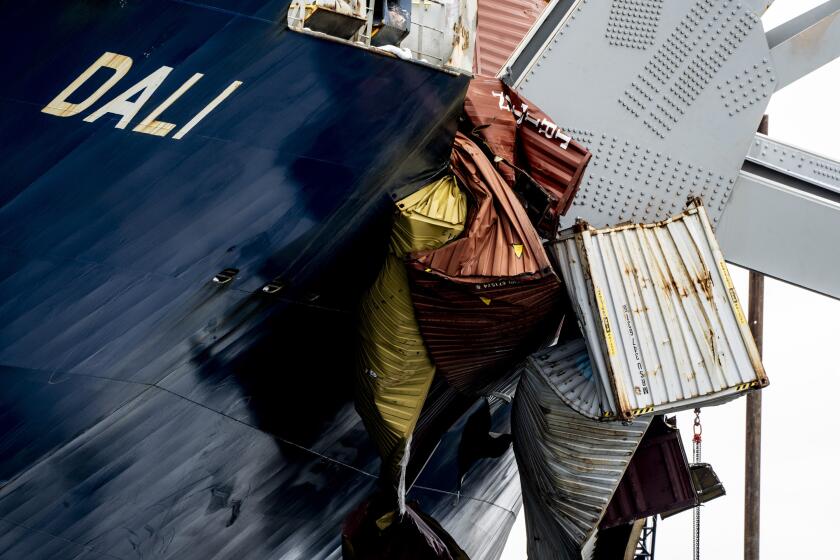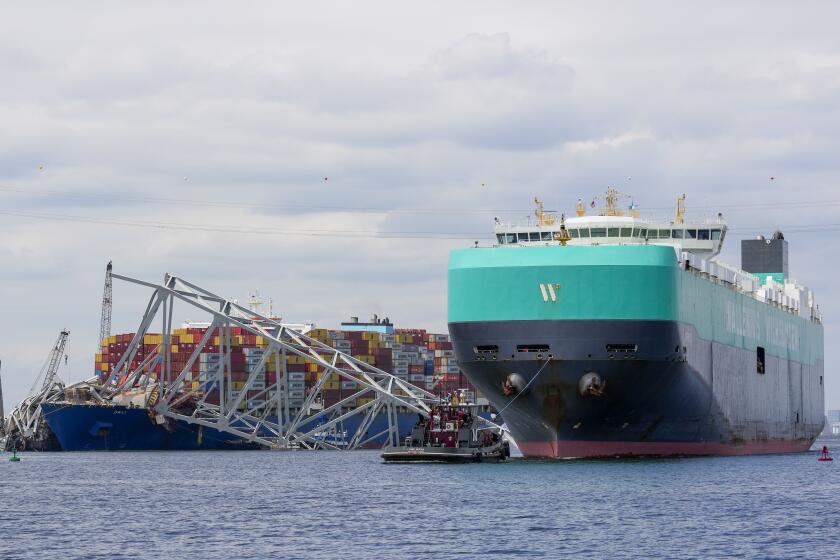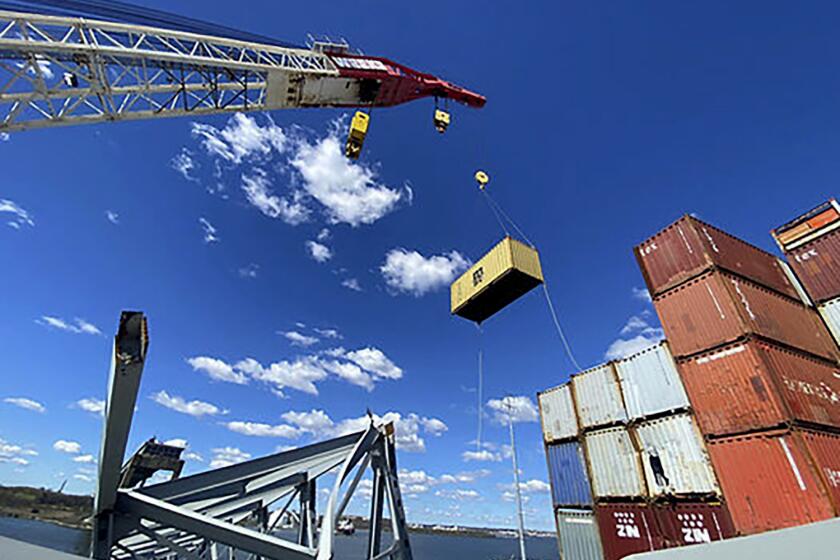Tugboats escort ship that caused deadly Baltimore bridge collapse back to port

- Share via
BALTIMORE — The recovery from the deadly Baltimore bridge collapse reached a significant milestone Monday as the ill-fated container ship Dali was slowly escorted back to port, its damaged bow still covered with smashed shipping containers, fallen steel trusses and mangled concrete.
Nearly two months have passed since the Dali lost power and crashed into one of the bridge’s supporting columns, killing six construction workers and halting most maritime traffic through the Port of Baltimore.
Refloated at high tide Monday morning, the vessel slowly backed away from the site of the March 26 disaster, guided by several tugboats. The extensive damage to its bow included a massive, gaping hole above the waterline on its starboard side.
A fuel barge has become the first vessel to use an alternate channel to bypass the wreckage of Baltimore’s collapsed Francis Scott Key Bridge.
Removing the hulking ship opened a new void in Baltimore’s skyline, which lost an iconic landmark and a symbol of the city’s proud maritime history. The altered waterscape also highlighted the progress made on the cleanup effort; crews have already cleared thousands of tons of mangled steel that once were visible jutting up from the water’s surface.
The bodies of the six victims have been recovered from the underwater wreckage — all Latino immigrants who came to the U.S. for job opportunities. They were filling potholes on an overnight shift when the bridge was destroyed.
Officials said the Dali would move at about 1 mph on the roughly 2.5-mile trip back to port, a fraction of the speed it was traveling when it lost power and brought down the bridge. It will spend several weeks getting temporary repairs at the same marine terminal it occupied before beginning its ill-fated voyage, and then move to a shipyard for more substantial repairs.
The first cargo ship passed through a newly opened channel in Baltimore after being stuck in the harbor since the Francis Scott Key Bridge collapsed.
To refloat the Dali, crews released anchors and pumped out more than 1 million gallons of water that had kept the ship grounded and stable during the complicated cleanup effort. Crews conducted a controlled demolition on May 13 to break down the largest remaining span of the collapsed bridge, which was draped across the Dali’s bow. Dive teams then confirmed the path was clear.
The Dali experienced two electrical blackouts about 10 hours before leaving the Port of Baltimore on its way to Sri Lanka. The crew later made changes to the ship’s electrical configuration, switching to a transformer and breaker system that had previously been out of use for several months, according to a preliminary report released last week by the National Transportation Safety Board.
Two more blackouts left the Dali without propulsion, drifting off course just as it was approaching the Key Bridge. By then, two tugboats that had guided the Dali out of port had peeled off — normal protocol, according to the report — but when the power went out, the tugs were too far away to help avert disaster.
Salvage crews have begun removing containers from the cargo ship that crashed into and collapsed the Francis Scott Key Bridge in Baltimore.
The FBI has also launched a criminal investigation into the circumstances leading up to the crash.
The ship’s crew members haven’t been allowed to leave the vessel. Officials said they’ve been busy maintaining the ship and assisting investigators, and will be able to disembark once the Dali is docked.
Officials plan to reopen the port’s 50-foot deep draft channel by the end of May. Until then, crews have established a temporary channel that’s slightly shallower.
Skene writes for the Associated Press.
More to Read
Sign up for Essential California
The most important California stories and recommendations in your inbox every morning.
You may occasionally receive promotional content from the Los Angeles Times.












